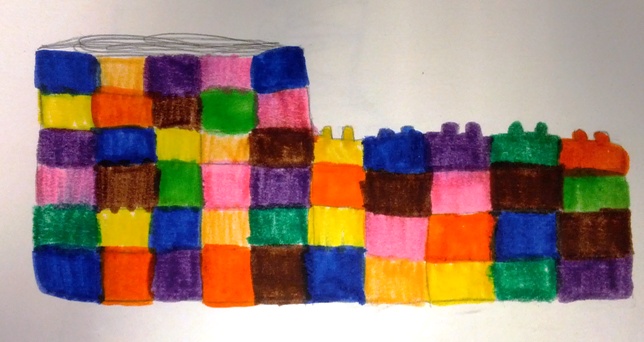The one thing that I have debated over is whether or not to give a child 0. I figure that I would only give a 0 when a student doesn’t hand in the work AT ALL. But how about my 0.5/day reduction for each day that it is late? I would pester the kids who haven’t handed in their work but because the worksheet is only out of 3, their per day deduction of points brings them down to a negative number. This is a predicament that I had to deal with today. If a student made the effort to write something and hand it in, even if it is not perfect and late, should they really ever deserve a 0? Unless they handed in to me a blank sheet or answers that are completely off base, then no. I think the lowest I will reduce their mark to is a 1.
Be the Facilitator
I had another formal observation recently. I was teaching special needs children and I really wanted to help all of them. I made sure that all of the students were spoken to and gave extra attention to those who needed the help. I spent more time with those who were behind or who were struggling to progress with their project. I wanted them to clean up early because the last thing I want happening is to have them go over and the bell rings. Especially not with my FA there. There was extra time and I was wondering what I should talk about. I began to chat with the kids individually so I could get a better sense of who they are. I enjoy getting to know them so sitting around chatting with the group is quite pleasant.
After the class was over, I had a debrief with my FA and she told me that I had good rapport with the students and was helpful to all the students who needed me; however, I needed to facilitate the entire class more. I made sure I walked around and talked to all the kids but I guess that wasn’t enough. I felt that some of the kids were quite independent and many “didn’t require my help”. I decided that I was going to help a couple of students who were behind but unfortunately, this was seen as taking away from my ability to facilitate the room. I agree and disagree. I made my judgement call and felt that I had spent time walking around making sure that they were all helped before focusing on a specific few. Nevertheless, teachers are supposed to be the facilitator of learning and not their buddy.
On top of the facilitating portion, I also needed to remember a few things when I teach. It has never really been broken down to me like this before, but it helps:
1. Intro (with review) – Set up an objective/goal for the class
2. Conclusion (review objective/goal) + preview of next class
I knew that all of these measures are important but it’s so easy to just forget! I need to make sure that I address these points each and every lesson, even if they’re just working periods. In addition to that, am I the ONLY person on earth who FORGETS to turn off the lights and close the blinds during a presentation? YES? I think so. I must have been so nervous/focused on what I was teaching the kids that I forgot to do this many times. My SA had to save my butt and turn off the lights for me. Embarrassed and relieved at the same time, I thanked her for doing this. I must really make a mental and literal note to do this every time I present!
Working Period
Today was Day 1 and I got to teach my Studio Art class again. They are working on their comics so when I told them they could begin drawing, they were excited just to get to work.
I started off talking about the consequences of losing their worksheet. It was necessary that I remind them so that they would take what I say seriously. If I didn’t, they would keep asking me for worksheets and lose them time after time. I got to speak to the class to address this issue and many of them did listen. I said that they would only get one sheet and if they lost it, they would need to copy the template off of a friend. There are still a few students who didn’t hand in their sheet but I got a good chunk of them to. I was especially proud of the students who were ELL and wrote their concept sheets in Chinese. I had a student in the class translate it into English for me! I really appreciated this help. When the ELL students were given the opportunity to communicate in their own language, I felt that they were better able to get their ideas across.
The afternoon was rather relaxing compared to the ones previous where I had to present and facilitate discussion. I walked around and talked to each of them to see how they were doing. The more quiet students were able to open up and it was pleasant to talk to them. I agree…with time, the students will eventually understand who I am as a teacher. I am a kind teacher and would ideally, have all my students succeed. It is also true though, that some students will just dislike you from the start. They’ve made up their minds about you and it’s not going to change. There is no point fighting those students.
One of the best tips that I heard from a fellow TC is that when you’re feeling a lot of negativity from your students, perhaps try to talk to those who are more positive. I’ve tried it and it does alleviate some of the anxiety, frustration, and disappointment I feel when I deal with disruptive students.
After class, I spent some time preparing for next week…aka the 80% load! Scary times…I want to be as mentally and physically prepared as possible, but as I’ve learned, the best preparation a teacher can do is to be flexible.
Shoe Design Assignment

I wanted the students to think conceptually about shoe design. I knew that many were stuck in the mode of thinking literally about shoes that are wearable (crocs, flats, runners). I felt that exercise could prompt them to think “outside of the box” and venture into the world of conceptual art. They were given about 20 minutes. Here are some examples of the in class assignment.
Consequences, Consequences
Today my FA observed me teach the ceramics class. I typically have trouble getting through to this group of students so naturally I was worried about my observation. I wanted to teach well but I also wanted to be relaxed while I teach. She called it a “performance” much like myself. I was going to have the students gather into groups that I assigned randomly, and encourage them to share their shoes with the group. The point of the exercise was to talk to each other about their design and development process.
The biggest difficulty I found with this is how quickly their conversations would go. They would describe it in a couple of sentences and call it a day. I guess I am used to the discussions that take place in university where people can elaborate for a long time. I forget that they are not used to these sort of discussions and are probably uncomfortable in sharing. Perhaps their ideas are there but they haven’t learned to articulate them. I am hoping that with more class discussions, they can feel comfortable.
Another barrier to the presentation was that my classroom is not presentation friendly. It is very long and often times, when I present, there are many students who sit in the far back who can barely see the projector. Unfortunately, this is the set up of the room and cannot be helped. For more formal presentations, I think I will have to address this by moving the tables aside and creating a round circle with the chairs.
During the debrief with my SA, she used the word “consequences” many times. I need to enforce my consequences on my students so they don’t keep acting out or taking advantage of my generosity. For instance, many students lost their concept sheets that they were supposed to hand in and I kept handing them out again. My SA said that I should come up with a plan to make sure they KEEP their sheets or else face negative consequences for losing them. One suggestion is that I tell the class that they only get 1 handout and no more. If you lose it, you will have to copy a friend’s sheet. No ifs, ands, or buts. I agree with this because photocopying all those sheets is a huge use of paper.
The other problem I am having is how to deal with smart aleck students. I had one in particular who would respond to my questions with “I don’t know” and roll his eyes and use sarcasm as a way to alleviate the challenging questions I would pose. It really frustrated me to see how he was undermining my authority and my intentions for him to learn. I’m not sure what to do but I think I will continue to just encourage him to think about his art and to mark him accordingly to the work he actually produces. I can only push so much.
I also began marking this week. It takes a LONG time! I can’t imagine marking academic papers. I marked the concept sheets based off my rubric I created. Most students did very well except for a couple who I knew rushed it. They deserve the low mark. I have the rubric to back me up.
Always expect the worst of a school’s Internet connection…
Before I taught today’s lesson on social justice artist, Rebecca Belmore, I sat in the staff room reviewing my slides and thinking to myself, what if the video doesn’t play? I wanted to show a video performance by Belmore to the class and have them analyse it. Suddenly, my gut feelings kicked in and told me that it wouldn’t work. It just wouldn’t play.
I immediately looked for screencaps of the performance and added it onto my powerpoint presentation in case I had to resort to this. When I attempted to play the video performance, it worked for a couple seconds and then it stopped. It didn’t work. I was told that the Internet connection there was shoddy and couldn’t be depended on. THANK GOODNESS FOR MY SCREENCAPS!! I was able to carry on the class discussion with my last minute screencap additions. Lesson learned….
Grouping the Students
Surprisingly, group dynamics play a huge role in determining the success of the class discussion. I battled with how I would approach the group discussion today. I decided that at the end of the day, the kids would be more comfortable with their group of friends. For one, many refuse to get out of their bums to move and secondly, they are more likely to talk to people they are comfortable with. The problem here however, is that certain groups of friends are generally more talkative or less talkative than others. I encountered this very problem today when I reached the group of ELL students. I knew they always sat together and I knew they were not big talkers. They did not pay attention most of the time in class either. I think their greatest fear is that they don’t think they could speak English. However, judging from their writing, their comprehension of the language seems fine. Granted, it is more difficult to speak sometimes than it is to write. I do understand that part in learning a new language.
Despite this, I continued to pressure this group to give an answer. I remember what it was like to be in that situation. I hated it. I hated it because I was often too shy to speak. Not because I didn’t know the answer. I was also too afraid to say the wrong answer or say something stupid. I do feel badly for the students who are struggling in class due to language barriers, but I am really trying to find a way to help them. I know that their understanding of English is far from perfect, but it is adequate. Adequate enough to participate in a class discussion and to complete the concept worksheet. I don’t want to come off as a teacher that is insensitive to my students. I attempted to mix in a native English speaker to their groups many times and this native English speaker always ends up being the talker. I don’t even know if the group even talked at all! This is the frustrating part about class engagement. Do I continue to push for entire class participation at the expense of precious time I could be using to teach new material? At this point in my practicum and my career, I feel like I need to find a balance. I must get through my material but I also must address the issue of class engagement. I realize now that many students in my art classes are there because they were forced into it. Many also sign up for this class to “slack off”. I don’t appreciate this and they certainly don’t appreciate me trying to make it academic. But this is my job and my true intentions as a teacher. I don’t want art class to be the “easy” class. I do want it to be enjoyable and educational at the same time. If I let a couple things slide, it would look bad on me during an observation. If I tried to catch everything that goes wrong during class, I would be unable to teach anything. So what is it then? What must I focus my attention on? I think that truthfully, I will be unable to catch all of the students who aren’t paying attention, no matter how interesting the subject is. I have come to accept that I need to find a fine balance between WHAT I have to deliver that day and WHO must absolutely pay attention to the material that I am teaching. Walking around the class certainly helps. They tend to put down their phones and start to “look up” once you have graced their presence.
A Shoe for a Raver
Today I worked with the same TOC from yesterday. She was supremely helpful in the classroom. She stepped in when she could sense that the students were feeling restless or bored. I really appreciated her suggestions and her attentiveness to the class I taught. I knew that my teaching still needs work.
I taught a special needs art class this morning. The more that I work with them, the more fond of them I become. They are so sweet and genuine. I find it a refreshing change from regular students. The non-special needs students seem to be more capable of trickery while the special needs students tell you directly what is on their mind. They continued working on their pinata project from weeks ago. I’m surprised at the amount of time it takes for them to complete certain projects! I need to take this into account when I start my unit with them.
The second class I taught was the ceramics class. This class was filled with Grade 10s who enjoyed talking and not necessarily about the things we were learning about. I had a quick presentation on shoes and engaged them in group discussions about different types of shoes. They had to discuss the nature of the shoe and who could possibly wear them. They struggled with the more conceptual and abstract shoes because they were looking at shoes as if they were meant to be literally worn. I walked around to help them expand their range of thinking. Think about the type of shoe that is depicted, the way it’s made, how it’s shaped, the designs and colours. They weren’t used to thinking conceptually.
After the discussion activity was over, I had the students choose a number between 1-30. The number they chose would determine the type of shoe they would need to design and hand in at the end of class. Some of these shoes that they had to design include “raver shoes”, “a bad driver’s shoes”, “a librarian’s shoes”, and “a philosopher’s shoes”. When they started to work, I could see that they began to think conceptually. The group discussion we had I think, really helped prompt them to design their shoes. I don’t think that without this scaffolding, their shoe designs would be much more plain and literal. Although I did have one student who seemed rather eager to get started on the actual ceramic project, I feel confident that the presentations that I am doing will allow them to produce a richer and better art piece.
Elements of Comics
Today I taught two of the same class back to back. It was the second to last lecture on comics and social justice. I knew that they were getting impatient to start so I figured I better speed things up. I can’t wait until the students begin actually working on their projects! I find that “lecturing” day after day is really exhausting.
After I presented, I found it interesting that the TOC said that all the material I presented could have been done over a span of many days. This is true. I absolutely believe each and every one of these comic elements could have been expanded on. What I felt pressed for was the time. The time I have to teach this class, the time I have to present my information, and the time they need to actually START their comic. It’s a delicate balancing act between choosing the most relevant material, finding when to introduce information to the students, and when they can begin their art project. This is probably the most challenging part about teaching.
I was aware of the fact that teachers face the pressures of having a decent class enrollment so that the course would not be cancelled. At this rate, if I were to teach any art classes, they would probably be cancelled! I feel that I come off as being “too stern”, “not fun”, and that my projects and assignments are boring/lame. My goal has always been to inspire my students to think critically about life and to understand that art is more than just craft making. Will they ever come to see this or am I fighting a losing battle? It is no wonder that so many teachers end up conforming to what the students/administrators desire for class curriculum.
Communicating with ELL students proved to be one the most difficult tasks that I face. I found that the best way for me to do this is to find a translator in class or to use Google Translator. Yes it is useful! I used plenty of gestures, pictures, and examples. It seems to be working!
Everyday I deal with students that are resistant to the project and my authority. I do find it easier to deal with as time goes on but I don’t know if I am actually motivating them. The lack of intrinsic motivation in my class is very apparent. Many are there because they think it is an “easy” course so when I make them work, they suddenly feel like banging their heads against the table. As a former high school student, I know that there are courses and projects that I absolutely loathed. I couldn’t see the point in learning what I thought was irrelevant material. When will I ever need to balance chemical equations in my life? I knew I was poor at chemistry so I my interest in the subject was low. I can understand that many students will see my project as being silly, but unlike balancing chemical equations, talking about social issues is completely relevant to the well being of our lives. I will continue to stick to my guns and show that I believe in what I am teaching. I will not let the students bring me down. So why did I title this, “Elements of Comics”? Well, in addition to teaching the actual elements that make up comics, I also learned to find laughter in everyday life. I can’t take the student’s supposed negative attitude towards me too seriously. I realize that as a teacher, it is my job to discipline and set boundaries.
Am I Doing This Right?
After two weeks into my practicum, I started to wonder if I am doing things right. I wonder if my front-end loading is too much. Is it “normal” to provide so much background information to art students before their project? I feel like I have gone to excessive lengths to inspire them but I am only met with stares of boredom.
Should my daily speech only be a welcome and “get to work”? I don’t know how teachers do it. Art teachers are known for facilitating studio work in a relaxed environment. Why do I feel that mine is so stiff? Maybe it is too early to tell because I also picked up 2 new classes this week. With the icebreakers and the introduction to the projects, it is making me feel dry in the mouth.
The kids WANT to start making art NOW. I can sense their anticipation. They don’t want to do concept sheets or sketchbook planning. They just want to tackle the project on the spot. I thought my goal is to show them different ways to approach a topic and inspire them to think beyond the normal realm of art making. Why do I feel such an urge to just drop everything and let them go wild with art materials? I think this is a sense of discomfort they feel towards this new approach. I like discipline, hard work, and creative thought. I want to view their process. I don’t know if I have conveyed that thoroughly.
This front end loading seems radical to many students. I’m putting art into the realm of academic subjects with my approach. I want art to have the respect it deserves as a school subject. It’s difficult for me to step into a classroom that has been well set up and to do a 180 with a different set of rules and expectations. I want them to succeed but I also do not want them to be bored. I realize that learning patience is a virtue but I myself, cannot wait for them to get started on their projects.
At the end of the day, I believe in my teaching approach for art. I am doing my best to inspire them with related concepts and artists. My hope is that they will learn so much more from doing these projects than they ever imagined.







